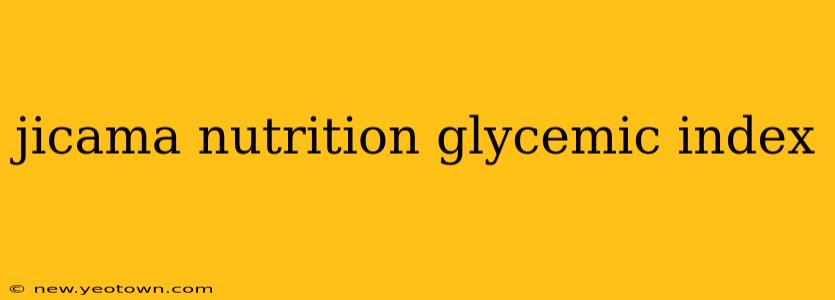Jicama, often called a yam bean or Mexican turnip, is a crunchy root vegetable gaining popularity for its unique texture and surprisingly impressive nutritional profile. It's a refreshing addition to salads, dips, and stir-fries, but beyond its culinary appeal lies a fascinating story of nutritional benefits and a surprisingly low glycemic index. Let's delve into the world of jicama, uncovering its secrets and answering some common questions.
What is the Glycemic Index (GI) of Jicama?
The glycemic index (GI) measures how quickly a carbohydrate-containing food raises blood sugar levels. Jicama boasts a remarkably low GI, typically ranging from 6-11. This means it's a slow-releasing carbohydrate, causing a gradual and less dramatic rise in blood sugar compared to high-GI foods like white bread or sugary drinks. This makes jicama an excellent choice for people managing blood sugar levels, including those with diabetes or prediabetes.
Is Jicama Good for Diabetics?
Yes, jicama's low glycemic index makes it a suitable addition to a diabetic-friendly diet. The slow release of carbohydrates helps prevent blood sugar spikes and crashes, promoting better blood sugar control. However, it's crucial to remember that portion control is still important, even with low-GI foods. While jicama offers benefits, it shouldn't replace other essential components of a balanced diabetic diet.
What are the Nutritional Benefits of Jicama?
Beyond its low glycemic index, jicama offers a wealth of nutritional benefits:
-
Rich in Fiber: Jicama is an excellent source of dietary fiber, crucial for digestive health. Fiber aids in regularity, promotes satiety (feeling full), and can contribute to lower cholesterol levels.
-
Good Source of Vitamin C: This powerful antioxidant supports the immune system and protects cells from damage.
-
Contains Potassium: An essential mineral for maintaining healthy blood pressure.
-
Provides Inulin: A type of prebiotic fiber that nourishes beneficial gut bacteria, promoting a healthy gut microbiome. This contributes to overall digestive and immune health.
-
Low in Calories: Jicama is relatively low in calories, making it a great addition to weight-management plans.
What are the potential downsides of eating jicama?
While generally safe and healthy, some individuals may experience minor digestive discomfort like bloating or gas, particularly if they consume large quantities. Also, individuals with fructose malabsorption issues may find that consuming large amounts of jicama can cause gastrointestinal distress. This is because jicama contains inulin, a type of fructan, a type of carbohydrate that some individuals struggle to digest.
How can I incorporate jicama into my diet?
Jicama's versatility makes it easy to incorporate into your diet. Its crisp texture lends itself well to various dishes:
- Salads: Add it raw, julienned, or diced into your favorite salad recipes.
- Dips and Snacks: Serve jicama sticks with hummus or guacamole.
- Stir-fries: Add jicama to stir-fries for a pleasant crunch.
- Juices and Smoothies: Incorporate jicama into juices and smoothies for added nutrients and sweetness.
How is Jicama different from other root vegetables?
Compared to other root vegetables like potatoes or sweet potatoes, jicama stands out with its lower calorie and carbohydrate content and notably lower glycemic index. Its unique, crunchy texture also sets it apart. While other root vegetables offer different nutritional benefits, jicama's combination of low GI and high fiber content makes it a particularly attractive option for those seeking to manage blood sugar and improve digestive health.
In conclusion, jicama is a versatile and nutritious root vegetable offering a unique combination of taste, texture, and health benefits. Its low glycemic index, high fiber content, and other nutritional advantages make it a valuable addition to a healthy and balanced diet. Remember to always consult with a healthcare professional or registered dietitian to determine how jicama fits into your specific dietary needs.

